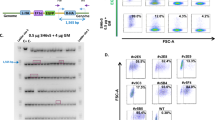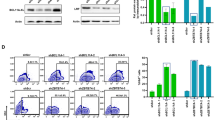Abstract
The development of oncoretrovirus vectors for human γ-globin has been hampered by problems of low expression and gene silencing. In order to address these problems, we investigated an enhancer element identified from individuals with deletional hereditary persistence of fetal hemoglobin 2 (HPFH2), a genetic condition characterized by elevated levels of γ-globin in adults. Plasmid transfection studies in erythroid MEL (murine erythroleukemia) cells demonstrated the HPFH2 element could function synergistically with the β-globin locus control region to enhance the expression of an Aγ-globin gene with a truncated −382 bp promoter. A series of oncoretrovirus vectors were subsequently generated that contain an expression cassette for Aγ-globin linked to various combinations of the HPFH2 enhancer, the α-globin HS40 enhancer, and several versions of the promoter from Aγ-globin or β-globin. Expression analysis in transduced MEL cell clones revealed very high levels of promoter-autonomous silencing that was at least partially abrogated by the HPFH2 enhancer. The vector containing a combination of a −201 bp Aγ-globin gene promoter with the Greek HPFH −117 point mutation and both the HPFH2 and HS40 enhancers exhibited no signs of vector silencing and was expressed at 248±99% per copy of mouse α-globin (62% of total α-globin). This represents a significant improvement over previously reported oncoretrovirus vectors for Aγ-globin, and demonstrates the capacity of the HPFH2 enhancer to abrogate sequence-autonomous silencing of the Aγ-globin promoter in the context of a gene transfer vector.
This is a preview of subscription content, access via your institution
Access options
Subscribe to this journal
Receive 12 print issues and online access
$259.00 per year
only $21.58 per issue
Buy this article
- Purchase on Springer Link
- Instant access to full article PDF
Prices may be subject to local taxes which are calculated during checkout






Similar content being viewed by others
References
Emery DW, Chen H, Li Q, Stamatoyannopoulos G . Development of a condensed locus control region cassette and testing in retrovirus vectors for Aγ-globin. Blood Cells Mol Dis 1998; 24: 322–339.
Ren S et al. Production of genetically stable high-titer retroviral vectors that carry a human γ-globin gene under the control of the alpha-globin locus control region. Blood 1996; 87: 2518–2524.
Li Q et al. Development of viral vectors for gene therapy of β-chain hemoglobinopathies: optimization of a γ-globin gene expression cassette. Blood 1999; 93: 2208–2216.
Emery DW, Morrish F, Li Q, Stamatoyannopoulos G . Analysis of γ-globin expression cassettes in retrovirus vectors. Hum Gene Ther 1999; 10: 877–888.
Emery DW et al. Development of virus vectors for gene therapy of β chain hemoglobinopathies: flanking with a chromatin insulator reduces γ-globin gene silencing in vivo. Blood 2002; 100: 2012–2019.
Sabatino DE et al. Development of a stable retrovirus vector capable of long-term expression of γ-globin mRNA in mouse erythrocytes. Ann NY Acad Sci 2001; 938: 246–261.
Emery DW, Stamatoyannopoulos G . Stem cell gene therapy for the β-chain hemoglobinopathies. Problems and progress. Ann NY Acad Sci 1999; 872: 94–107.
Bunn FH . Human hemoglobins: sickle hemoglobin and other mutants. In: Stamatoyannopoulos G, Majerus PW, Perlmutter RM, Varmus H (eds). Molecular Basis of Blood Diseases. Saunders: Philadelphia, 2001, pp 183–226.
Emery DW et al. Hematopoietic stem cell gene therapy. Int J Hematol 2002; 75: 228–236.
Kohn DB . Gene therapy for genetic haematological disorders and immunodeficiencies. J Intern Med 2001; 249: 379–390.
Horn PA et al. Highly efficient gene transfer into baboon marrow repopulating cells using GALV-pseudotype oncoretroviral vectors produced by human packaging cells. Blood 2002; 100: 3960–3967.
Rivella S, Sadelain M . Genetic treatment of severe hemoglobinopathies: the combat against transgene variegation and transgene silencing. Semin Hematol 1998; 35: 112–125.
Li Q, Peterson KR, Fang X, Stamatoyannopoulos G . Locus control regions. Blood 2002; 100: 3077–3086.
Stamatoyannopoulos G, Josephson B, Zhang JW, Li Q . Developmental regulation of human γ-globin genes in transgenic mice. Mol Cell Biol 1993; 13: 7636–7644.
Nienhuis AW et al. Development of gene therapy for hemoglobin disorders. Ann NY Acad Sci 2003; 996: 101–111.
Higgs DR et al. A major positive regulatory region located far upstream of the human alpha-globin gene locus. Genes Dev 1990; 4: 1588–1601.
Emery DW, Yannaki E, Tubb J, Stamatoyannopoulos G . A chromatin insulator protects retrovirus vectors from chromosomal position effects. Proc Natl Acad Sci USA 2000; 97: 9150–9155.
Li Q et al. Differences of globin transgene expression in stable transfected cell lines and transgenic mice. Blood 2005; 105: 3346–3352.
Stamatoyannopoulos G, Grosveld F . Hemoglobin switching. In: Stamatoyannopoulos G, Majerus PW, Perlmutter RM, Varmus H (eds). Molecular Basis of Blood Diseases. Saunders: Philadelphia, 2001, pp 135–182.
Anagnou NP et al. Sequences located 3′ to the breakpoint of the hereditary persistence of fetal hemoglobin-3 deletion exhibit enhancer activity and can modify the developmental expression of the human fetal Aγ-globin gene in transgenic mice. J Biol Chem 1995; 270: 10256–10263.
Arcasoy MO et al. High levels of human γ-globin gene expression in adult mice carrying a transgene of deletion-type hereditary persistence of fetal hemoglobin. Mol Cell Biol 1997; 17: 2076–2089.
Katsantoni EZ et al. Persistent γ-globin expression in adult transgenic mice by HPFH-2, HPFH-3, and HPFH-6 breakpoint sequences. Blood 2003; 102: 3412–3419.
Yu M et al. The proximal promoter harbors the genetic information for autonomous silencing of the human γ-globin gene. Blood Cells Mol Dis 2005; 34: 132–133.
Sambrook J, Fritsch EF, Maniatis T . Molecular Cloning: A Laboratory Manual. Cold Spring Harbor Press: New York, 1989.
Forrester WC, Novak U, Gelinas R, Groudine M . Molecular analysis of the human β-globin locus activation region. Proc Natl Acad Sci USA 1989; 86: 5439–5443.
Miller AD, Buttimore C . Redesign of retrovirus packaging cell lines to avoid recombination leading to helper virus production. Mol Cell Biol 1986; 6: 2895–2902.
Markowitz D, Goff S, Bank A . A safe packaging line for gene transfer: separating viral genes on two different plasmids. J Virol 1988; 62: 1120–1124.
Enver T et al. Developmental regulation of fetal to adult globin gene switching in human fetal erythroid × mouse erythroleukemia cell hybrids. Dev Biol 1991; 148: 129–137.
McBurney MW . The mouse Pgk-1 gene promoter contains an upstream activator sequence. Nucleic Acids Res 1991; 19: 5755–5761.
Miller AD, Rosman GJ . Improved retroviral vectors for gene transfer and expression. Biotechniques 1989; 7: 980–990.
Bodine DM et al. Development of a high-titer retrovirus producer cell line capable of gene transfer into rhesus monkey hematopoietic stem cells. Proc Natl Acad Sci USA 1990; 87: 3738–3742.
Thorpe SJ et al. Immunochemical estimation of haemoglobin types in red blood cells by FACS analysis. Br J Haematol 1994; 87: 125–132.
Acknowledgements
We thank Qiliang Li for γ-globin gene expression plasmids and expert advice and assistance with the RNase protection analysis. We also thank Theodore Kosteas for his technical assistance. This work was supported in part by National Institutes of Health Grants HL53750, HL66947 and HL75713, and by a European Union and the National Secretariat of Research and Technology of Greece EKBAN 94 Grant.
Author information
Authors and Affiliations
Rights and permissions
About this article
Cite this article
Fragkos, M., Anagnou, N., Tubb, J. et al. Use of the hereditary persistence of fetal hemoglobin 2 enhancer to increase the expression of oncoretrovirus vectors for human gamma-globin. Gene Ther 12, 1591–1600 (2005). https://doi.org/10.1038/sj.gt.3302566
Received:
Accepted:
Published:
Issue Date:
DOI: https://doi.org/10.1038/sj.gt.3302566



